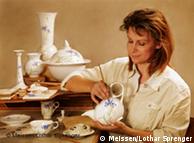(b Schleiz, 4 Feb 1682; d Dresden, 13 March 1719). German chemist and inventor. With the assistance of the scientist and mathematician Ehrenfried Walther von Tschirnhaus (1651-1708), he initiated experiments for the manufacture of gold from base metals (alchemy). This attempt attracted the attention of Frederick-Augustus I, Elector of Saxony, who obtained Böttger's services and kept him under virtual house arrest. The creation of gold did not succeed, but Böttger first developed a red stoneware called Jaspis-porzellan and then on 28 March 1709 discovered ‘true' or hard-paste porcelain, which had until then only been produced in China and Japan. A factory was established in the Albrechtsburg in Meissen on 6 June 1710. There Böttger worked with David Köhler, Paul Wildenstein and Samuel Stöltzel to refine the new material and to create the necessary colours to decorate it. Initially the shapes were designed by the court goldsmith Johann Jacob Irminger (1635-1724), who in 1712 assumed the role of artistic director at the factory. Böttger's porcelain was creamy white and could be potted very thinly. Böttger did not see his invention reach its full potential, as very few satisfactory enamel colours had been created by the time of his death. His discovery, however, was to create a fashion for porcelain all over Germany for the next 60 years.
Money Talks | 16.01.2008 | 04:30
Porcelain Made In Meissen Celebrates 300th Anniversary
On January 15th, 1708, the pharmacist Johann Friedrich Böttger in the city of Meissen, made a small note in his lab book that changed the town forever. It was the first record of porcelain made in Europe.
Three years later, the "white gold" became the basis for the "Royal Polish and Sachsen Porcelain Factory" in Meissen. Today, the company has an annual turnover of 36 million euros and a workforce of 800. Meissen Porcelain is synonymous around the world with luxury and quality design.
Reporter: Hardy Graupner

沒有留言:
張貼留言